recommended oil MITSUBISHI SHOGUN 2003 Owner's Manual (in English)
[x] Cancel search | Manufacturer: MITSUBISHI, Model Year: 2003, Model line: SHOGUN, Model: MITSUBISHI SHOGUN 2003Pages: 392, PDF Size: 14.34 MB
Page 196 of 392
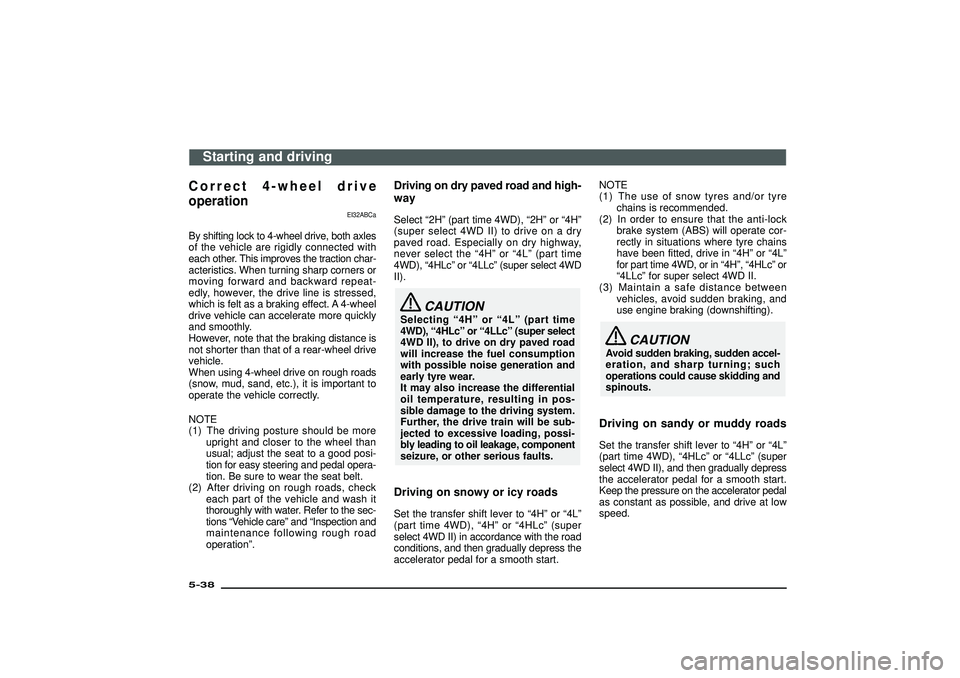
Correct 4-wheel drive
operation
EI32ABCa
By shifting lock to 4-wheel drive, both axles
of the vehicle are rigidly connected with
each other. This improves the traction char-
acteristics. When turning sharp corners or
moving forward and backward repeat-
edly, however, the drive line is stressed,
which is felt as a braking effect. A 4-wheel
drive vehicle can accelerate more quickly
and smoothly.
However, note that the braking distance is
not shorter than that of a rear-wheel drive
vehicle.
When using 4-wheel drive on rough roads
(snow, mud, sand, etc.), it is important to
operate the vehicle correctly.
NOTE
(1) The driving posture should be more
upright and closer to the wheel than
usual; adjust the seat to a good posi-
tion for easy steering and pedal opera-
tion. Be sure to wear the seat belt.
(2) After driving on rough roads, check
each part of the vehicle and wash it
thoroughly with water. Refer to the sec-
tions“Vehicle care”and“Inspection and
maintenance following rough road
operation”.
Driving on dry paved road and high-
waySelect“2H”(part time 4WD),“2H”or“4H”
(super select 4WD II) to drive on a dry
paved road. Especially on dry highway,
never select the“4H”or“4L”(part time
4WD),“4HLc”or“4LLc”(super select 4WD
II).
CAUTION
Selecting“4H”or“4L”(part time
4WD),“4HLc”or“4LLc”(super select
4WD II), to drive on dry paved road
will increase the fuel consumption
with possible noise generation and
early tyre wear.
It may also increase the differential
oil temperature, resulting in pos-
sible damage to the driving system.
Further, the drive train will be sub-
jected to excessive loading, possi-
bly leading to oil leakage, component
seizure, or other serious faults.Driving on snowy or icy roadsSet the transfer shift lever to“4H”or“4L”
(part time 4WD),“4H”or“4HLc”(super
select 4WD II) in accordance with the road
conditions, and then gradually depress the
accelerator pedal for a smooth start.NOTE
(1) The use of snow tyres and/or tyre
chains is recommended.
(2) In order to ensure that the anti-lock
brake system (ABS) will operate cor-
rectly in situations where tyre chains
have been fitted, drive in“4H”or“4L”
for part time 4WD, or in“4H”,“4HLc”or
“4LLc”for super select 4WD II.
(3) Maintain a safe distance between
vehicles, avoid sudden braking, and
use engine braking (downshifting).
CAUTION
Avoid sudden braking, sudden accel-
eration, and sharp turning; such
operations could cause skidding and
spinouts.Driving on sandy or muddy roadsSet the transfer shift lever to“4H”or“4L”
(part time 4WD),“4HLc”or“4LLc”(super
select 4WD II), and then gradually depress
the accelerator pedal for a smooth start.
Keep the pressure on the accelerator pedal
as constant as possible, and drive at low
speed.
Starting and driving
5-38Div:
Out put date:
Page 276 of 392
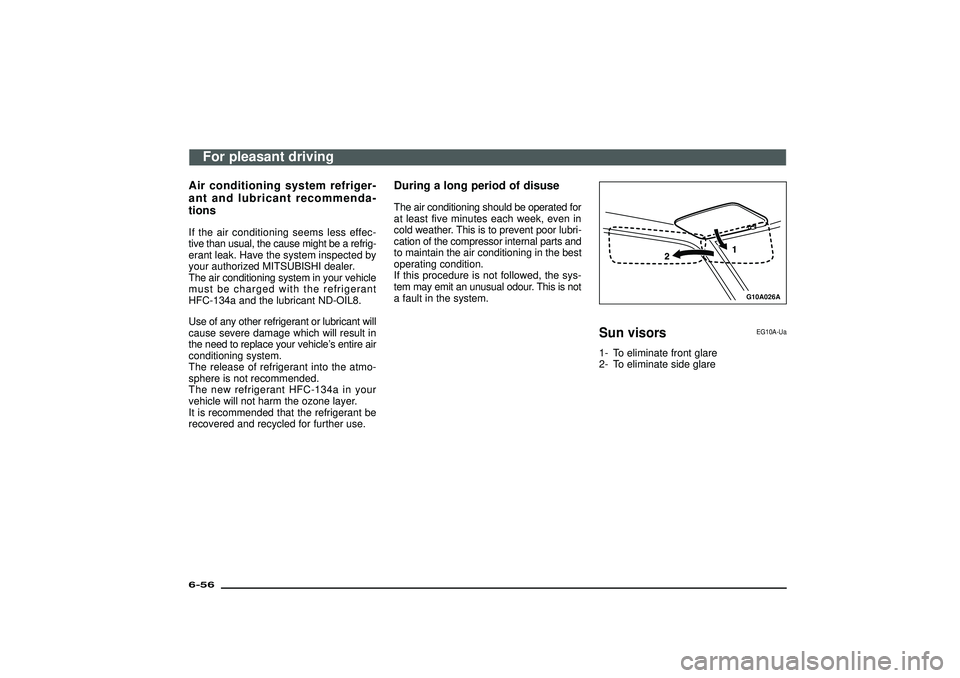
Air conditioning system refriger-
ant and lubricant recommenda-
tionsIf the air conditioning seems less effec-
tive than usual, the cause might be a refrig-
erant leak. Have the system inspected by
your authorized MITSUBISHI dealer.
The air conditioning system in your vehicle
must be charged with the refrigerant
HFC-134a and the lubricant ND-OIL8.
Use of any other refrigerant or lubricant will
cause severe damage which will result in
the need to replace your vehicle’s entire air
conditioning system.
The release of refrigerant into the atmo-
sphere is not recommended.
The new refrigerant HFC-134a in your
vehicle will not harm the ozone layer.
It is recommended that the refrigerant be
recovered and recycled for further use.
During a long period of disuseThe air conditioning should be operated for
at least five minutes each week, even in
cold weather. This is to prevent poor lubri-
cation of the compressor internal parts and
to maintain the air conditioning in the best
operating condition.
If this procedure is not followed, the sys-
tem may emit an unusual odour. This is not
a fault in the system.
G10A026A
Sun visors
EG10A-Ua
1- To eliminate front glare
2- To eliminate side glare
For pleasant driving
6-56Div:
Out put date:
Page 344 of 392
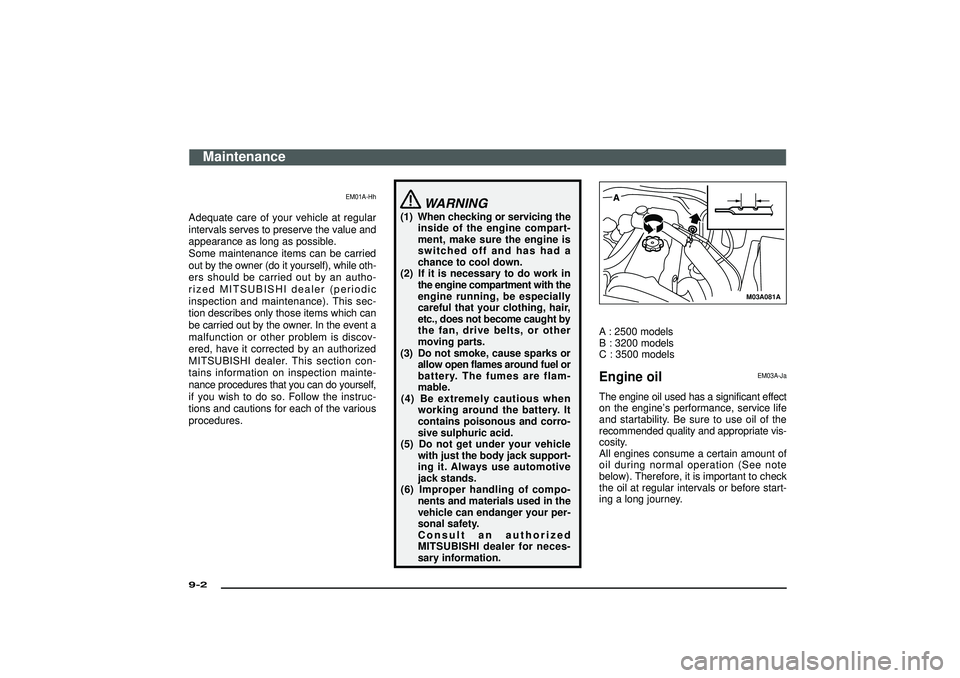
EM01A-Hh
Adequate care of your vehicle at regular
intervals serves to preserve the value and
appearance as long as possible.
Some maintenance items can be carried
out by the owner (do it yourself), while oth-
ers should be carried out by an autho-
rized MITSUBISHI dealer (periodic
inspection and maintenance). This sec-
tion describes only those items which can
be carried out by the owner. In the event a
malfunction or other problem is discov-
ered, have it corrected by an authorized
MITSUBISHI dealer. This section con-
tains information on inspection mainte-
nance procedures that you can do yourself,
if you wish to do so. Follow the instruc-
tions and cautions for each of the various
procedures.
WARNING
(1) When checking or servicing the
inside of the engine compart-
ment, make sure the engine is
switched off and has had a
chance to cool down.
(2) If it is necessary to do work in
the engine compartment with the
engine running, be especially
careful that your clothing, hair,
etc., does not become caught by
the fan, drive belts, or other
moving parts.
(3) Do not smoke, cause sparks or
allow open flames around fuel or
battery. The fumes are flam-
mable.
(4) Be extremely cautious when
working around the battery. It
contains poisonous and corro-
sive sulphuric acid.
(5) Do not get under your vehicle
with just the body jack support-
ing it. Always use automotive
jack stands.
(6) Improper handling of compo-
nents and materials used in the
vehicle can endanger your per-
sonal safety.
Consult an authorized
MITSUBISHI dealer for neces-
sary information.
M03A081A
A : 2500 models
B : 3200 models
C : 3500 modelsEngine oil
EM03A-Ja
The engine oil used has a significant effect
on the engine’s performance, service life
and startability. Be sure to use oil of the
recommended quality and appropriate vis-
cosity.
All engines consume a certain amount of
oil during normal operation (See note
below). Therefore, it is important to check
the oil at regular intervals or before start-
ing a long journey.
Maintenance
9-2Div:
Out put date:
Page 345 of 392
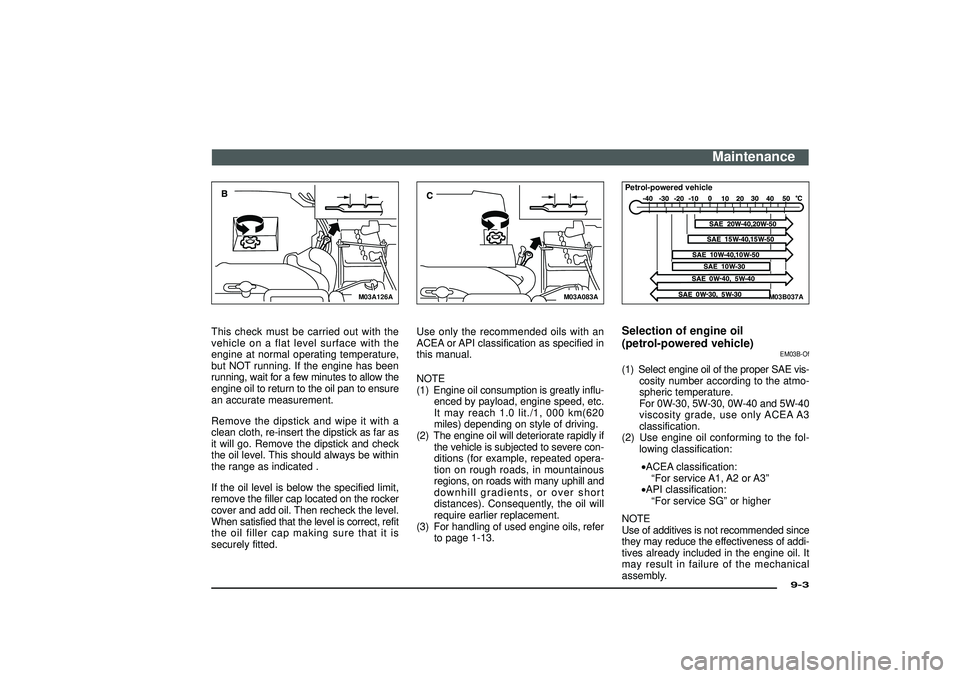
M03A126A
This check must be carried out with the
vehicle on a flat level surface with the
engine at normal operating temperature,
but NOT running. If the engine has been
running, wait for a few minutes to allow the
engine oil to return to the oil pan to ensure
an accurate measurement.
Remove the dipstick and wipe it with a
clean cloth, re-insert the dipstick as far as
it will go. Remove the dipstick and check
the oil level. This should always be within
the range as indicated .
If the oil level is below the specified limit,
remove the filler cap located on the rocker
cover and add oil. Then recheck the level.
When satisfied that the level is correct, refit
the oil filler cap making sure that it is
securely fitted.
M03A083A
Use only the recommended oils with an
ACEA or API classification as specified in
this manual.
NOTE
(1) Engine oil consumption is greatly influ-
enced by payload, engine speed, etc.
It may reach 1.0 lit./1, 000 km(620
miles) depending on style of driving.
(2) The engine oil will deteriorate rapidly if
the vehicle is subjected to severe con-
ditions (for example, repeated opera-
tion on rough roads, in mountainous
regions, on roads with many uphill and
downhill gradients, or over short
distances). Consequently, the oil will
require earlier replacement.
(3) For handling of used engine oils, refer
to page 1-13.
M03B037A
Petrol-powered vehicleSelection of engine oil
(petrol-powered vehicle)
EM03B-Of
(1) Select engine oil of the proper SAE vis-
cosity number according to the atmo-
spheric temperature.
For 0W-30, 5W-30, 0W-40 and 5W-40
viscosity grade, use only ACEA A3
classification.
(2) Use engine oil conforming to the fol-
lowing classification:
•ACEA classification:
“For service A1, A2 or A3”
•API classification:
“For service SG”or higher
NOTE
Use of additives is not recommended since
they may reduce the effectiveness of addi-
tives already included in the engine oil. It
may result in failure of the mechanical
assembly.
Maintenance
9-3
Div:
Out put date:
Page 346 of 392
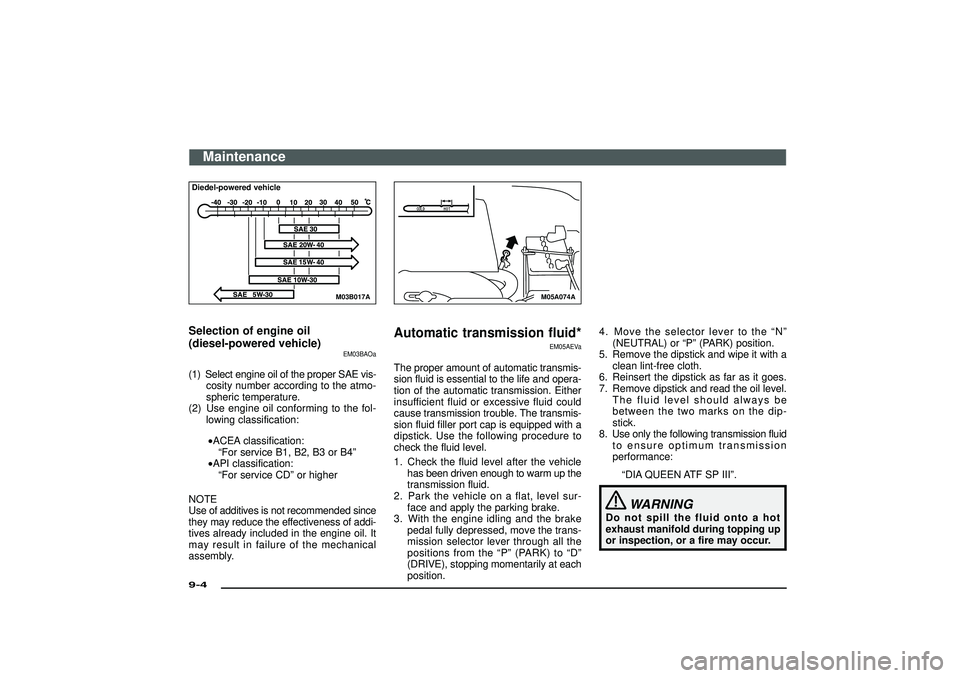
M03B017A
Diedel-powered vehicleSelection of engine oil
(diesel-powered vehicle)
EM03BAOa
(1) Select engine oil of the proper SAE vis-
cosity number according to the atmo-
spheric temperature.
(2) Use engine oil conforming to the fol-
lowing classification:
•ACEA classification:
“For service B1, B2, B3 or B4”
•API classification:
“For service CD”or higher
NOTE
Use of additives is not recommended since
they may reduce the effectiveness of addi-
tives already included in the engine oil. It
may result in failure of the mechanical
assembly.
M05A074A
Automatic transmission fluid*
EM05AEVa
The proper amount of automatic transmis-
sion fluid is essential to the life and opera-
tion of the automatic transmission. Either
insufficient fluid or excessive fluid could
cause transmission trouble. The transmis-
sion fluid filler port cap is equipped with a
dipstick. Use the following procedure to
check the fluid level.
1. Check the fluid level after the vehicle
has been driven enough to warm up the
transmission fluid.
2. Park the vehicle on a flat, level sur-
face and apply the parking brake.
3. With the engine idling and the brake
pedal fully depressed, move the trans-
mission selector lever through all the
positions from the“P”(PARK) to“D”
(DRIVE), stopping momentarily at each
position.4. Move the selector lever to the“N”
(NEUTRAL) or“P”(PARK) position.
5. Remove the dipstick and wipe it with a
clean lint-free cloth.
6. Reinsert the dipstick as far as it goes.
7. Remove dipstick and read the oil level.
The fluid level should always be
between the two marks on the dip-
stick.
8. Use only the following transmission fluid
to ensure optimum transmission
performance:
“DIA QUEEN ATF SP III”.
WARNING
Do not spill the fluid onto a hot
exhaust manifold during topping up
or inspection, or a fire may occur.
Maintenance
9-4Div:
Out put date:
Page 380 of 392

Capacities
EQ02AOIc
N o . Item Quantity Recommended lubricants1 Engine oil 2500 models
Oil pan 6.3 litres
Refer to page 9-2.
Oil filter 0.8 litre
Oil cooler 0.3 litre
3200 models Oil pan 7.5 litres
Oil filter 1.0 litre
Oil cooler 1.3 litres
3500 models Oil pan 4.3 litres
Oil filter 0.3 litre
Oil cooler 0.3 litre
2 Automatic transmission fluid 9.7 litres DIA QUEEN ATF SP III
3 Brake fluid As required Brake fluid DOT 3 or DOT 4
4 Clutch fluid As requiredSpecifications
10-16Div:
Out put date:
Page 381 of 392

N o . Item Quantity Recommended libricants
5 Washer fluidFront 6.0 litres
−
Rear 1.4 litres
6 Power steering fluid 1.0 litre ATF DEXRON III or DEXRON II
7 Engine coolantWithout rear heater/
rear air conditioning9.0 litres
DIA QUEEN SUPER LONG LIFE COOLANT or equivalent
(Includes 0.65 litre in the reserve tank)
With rear heater/
rear air conditioning10.5 litres
8Manual transmis-
sion oilSuper select 4WD models 3.2 litres
Gear oil API classification GL-4 SAE 75W-85W or 75W-90 Part-time 4WD models 5.1 litres
9 Transfer oilSuper select 4WD models 2.8 litres
Part-time 4WD models 2.5 litres
10 Differential oilFront 1.15 litresHypoid gear oil API classification GL-5 or higher
Above 10°C SAE 90
Below 10°C SAE 80W Rear 1.6 litres
11Refrigerant
(air conditioning)Without rear air conditioning 480-520g
HFC-134a
With rear air conditioning 760-800g
NOTE
Points requiring routine inspection or replenishment such as the engine oil, coolant, brake fluid are marked white for easy identification.
Specifications
10-17
Div:
Out put date: